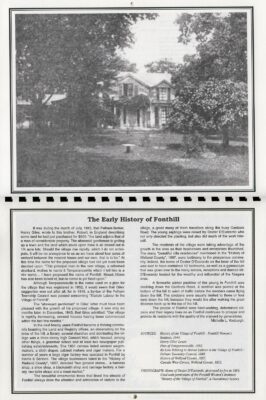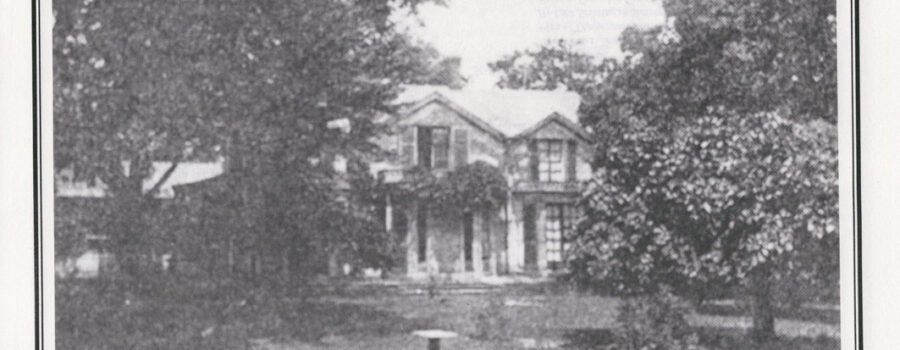 It was during the month of July, 1843, that Pelham farmer, Henry Giles, wrote to this brother, Robert, in England describing some land he had just purchased for $600: “the land adjoins that of a man of considerable property. The aforesaid gentleman is getting up a town and the land which abuts upon mine is all staked out in 1/4 acre lots . Should the village rise rapidly, which I do not anticipate, it will be no annoyance to us as we have about four acres of orchard between the nearest house and our own, that is to be.” At this time the name for the proposed village had not yet even been decided upon: “This principal man in the new village, a reformed drunkard, wishes to name it Temperanceville which I tell him is a vile name… I have proposed the name of Fonthill. Mount Albion has also been talked of, but no name is yet fixed upon.”
It was during the month of July, 1843, that Pelham farmer, Henry Giles, wrote to this brother, Robert, in England describing some land he had just purchased for $600: “the land adjoins that of a man of considerable property. The aforesaid gentleman is getting up a town and the land which abuts upon mine is all staked out in 1/4 acre lots . Should the village rise rapidly, which I do not anticipate, it will be no annoyance to us as we have about four acres of orchard between the nearest house and our own, that is to be.” At this time the name for the proposed village had not yet even been decided upon: “This principal man in the new village, a reformed drunkard, wishes to name it Temperanceville which I tell him is a vile name… I have proposed the name of Fonthill. Mount Albion has also been talked of, but no name is yet fixed upon.”
Although Temperanceville is the name used on a plan for the village that was registered in 1852, it would seem that Giles’ suggestion won out after all, for in 1848, a by-law of the Pelham Township Council was passed concerning “Statute Labour in the Village of Fonthill”.
The “aforesaid gentleman” in Giles’ letter must have been pleased with the growth of his proposed village. It was only six months later, in December, 1843, that Giles admitted: “Our village is rapidly increasing, several houses having been commenced within the last few months.”
In the next twenty years Fonthill became a thriving community boasting the Land and Registry offices, an observatory on the brow of the hill, a library, several churches and dominating the vil. lage was a three-storey high Concert Hall, which housed, among other things, a grammar school and at least two newspaper publishing establishments. The 1851 census listed several wagon-makers, a cloth draper, cabinet makers and cigar makers. For a number of years a large cigar factory was operated in Fonthill by Harris & Berston. The village businesses listed in the “History of Welland County”, 1887, included “two general stores… a harness shop, a shoe shop, a blacksmith shop and carriage factory, a bakery, two tailor shops and a meat market.”
The beautiful ornamental trees that lined the streets of Fonthill always drew the attention and admiration of visitors to the village, a great many of them travellers along the busy Canboro Road. The young saplings were raised by Dexter D’Everardo who not only directed the planting, but also did much of the work himself.
The residents of the village were taking advantage of the growth in the area as their businesses and enterprises flourished.
The many ‘beautiful villa residences” mentioned in the “History of Welland County”, 1887, were testimony to the prosperous community. Indeed, the home of Dexter D’Everardo on the brow of the hill was said to have contained 12 bedrooms, as well as a gymnasium that was given over to the many socials, receptions and dances Mr.D’Everardo hosted for the wealthy and influential of the Niagara area.
A favourite winter pastime of the young in Fonthill was sledding down the Canboro Road. A sentinel was posted at the bottom of the hill to warn of traffic before the sledders came flying down the hill. The sledders were usually limited to three or four runs down the hill, because they would tire after walking the great distance back up to the top of the hill.
The people of Fonthill were hard-working, determined citizens and their legacy lives on as Fonthill continues to prosper and provide its residents with the quality of life enjoyed by generations.
Origins of the name Fonthill, and the development of the village; Pelham Historical Calendar 1993: The Early History of Fonthill; Vosburgh, Michelle L., Author
Original Source: https://vitacollections.ca/pelhamlocalhistory/details.asp?ID=2428385
SOURCES: History of the Village of Fonthill – Fonthill Women’s Institute, 1944.
Henry Giles’ Letter.
Plan of Temperanceville, 1852.
By-Law Relating to Statute Labour in the Village of Fonthill – Pelham Township Council, 1848.
History of Welland County, 1887.
Canada West Census, Welland County, 1851.
PHOTOGRAPH: Home of Dexter D’Everardo, destroyed by fire in 1893.
Used with permission of the Fonthill Women’s Institute;
“History of the Village of Fonthill”, a Tweedsmuir history
 Back to myNiagaraOnline
Back to myNiagaraOnline
































